|
|
 |
|
Calanoida ( Order ) |
|
|
|
Arietelloidea ( Superfamily ) |
|
|
|
Heterorhabdidae ( Family ) |
|
|
|
Heterorhabdus ( Genus ) |
|
|
| |
Heterorhabdus pustulifer Farran, 1929 (F,M) | |
| | | | | | | Syn.: | Heterorhabdus austrinus : Bradford, 1971 b (p.24, fig.96:M);
Heterorhabdus (Heterorhabdus) pustulifer : Bradford-Grieve,1999 b (p.85, figs.F,M, Rem., figs.175, 191); | | | | Ref.: | | | Farran, 1929 (p.209, 266, Descr.F, figs.F); Vervoort, 1951 (p.128, Rem.); 1957 (p.132, figs.F, Rem.); Bradford, 1971 a (p.127, fig.M, Rem.); 1971 b (p.26, fig.F); Séret, 1979 (p.149, figs.F,M); Park, 2000 (p.124, figs.F,M, Rem.) |  issued from : Vervoort W. in B.A.N.Z. Antarctic Research Expedition, Rep.-Ser. B. III, 1957 . [Fig.123]. Female (from 55°11'S, 55°51'E): a, posterior part cephalothorax and urosome (lateral view from right side); b, P5 (psterior aspect).
|
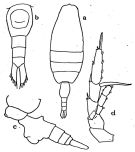 issued from : G.P. Farran in British Antarctic (\"Terra Nova\") Expedition, 1910. Natural History Reports. Zoology. Vol. VIII. Crustacea, 1929. [p.266, Fig.27]. Female: a, habitus (dorsal view); b, urosome (ventral view); c, distal part of prosome and urosome (left lateral view); d, fifth foot.
|
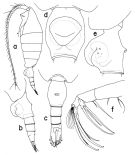 issued from : T. Park in Bull. Scripps Inst. Oceanogr. Univ. California, San Diego, 2000, 31. [p.244, Fig.92]. Female: a, habitus (left side); b, c, urosome (left, dorsal, respectively); d, e, genital somite (ventral, left, respectively); f, left Mx2 (posterior). Nota: Length ratios of 4 urosomal somite and left caudal ramus 37.4 : 16.6 : 15.9 : 8.6 : 21.5 = 100. A1 reaching about posterior end of 3rd urosomal somite. Mx2: Posterior subterminal spine of 4th lobe relatively long, 66% as long as 2nd saberlike spine. Exopod of P1 with 1st outer spine extending beyond distal end of segment by about 1/5 its length. P5: 3rd exopodal segment about as long as combined lengths of first 2 segments; outer spine of 2nd segment pointing straight distad. Dorsal appendicular seta of left caudal ramus approximately 1.5 times length of that of riht ramus. Anteriorly, anal segment with 2 pores on each side; each caudal ramus with 3 pores.
|
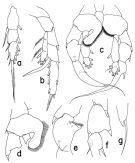 issued from : T. Park in Bull. Scripps Inst. Oceanogr. Univ. California, San Diego, 2000, 31. [p.245, Fig.93]. Female: a, exopod of P1 (anterior); b, P5 (posterior). Male: c, P5 (anterior); d, basipod of right P5 (anterior); e, second exopodal segment of right P5 (anterior); f, exopodal of left P5 (anterior); g, distal end of exopod of right P5 (lateral).
|
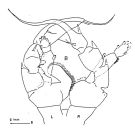 issued from : J.M. Bradford-Grieve in The Marine Fauna of New Zealand: Pelagic Calanoid Copepoda. National Institute of Water and Atmospheric Research (NIWA). NIWA Biodiversity Memoir, 111, 1999. [p.85, Fig.52]. Male: B, P5 (L = left leg; R = right leg).
|
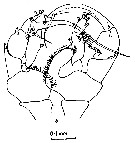 issued from : J.M. Bradford in N.Z. Jl mar. freshw. Res., 1971, 5 (1). [p.128, Fig.7, a]. Male (from 61-63°S, 170°30'E & 45°55'S, 171°05'E): a, P5. Nota: Basis of right P5 with inner lobe directed almost entirely to mid-line, so that, when mounted, lobe appears neither twisted nor constricted at base. Right exopodal segment 3 has terminal spine about 1/2 length of exopodal segment 3. It differs from closely related H. pacificus which has right exopodal segment 3 terminal spine more than 3/4 the length of exopodal segment 3, in having this spine only 1/2 the length of exopodal sement 3.
|
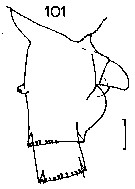 Issued from : J.M. Bradford in N.Z. Oceanogr. Inst., 1971, 206, Part 8, No 59. [p.25, Fig.101]. Female (from 75°09'S, 171°00'W): 101, genital and 2nd urosomal segments (right side). Scale bar: 100 µm.
|
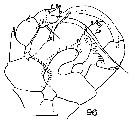 Issued from : J.M. Bradford in N.Z. Oceanogr. Inst., 1971, 206, Part 8, No 59. [p.24, Fig.96]. As Hererorhabdus austrinus. Male (from Ross Sea): 96, P5.
|
 Heterorhabdus pustulifer Heterorhabdus pustulifer female: 1 - See key to species groups of Heterorhabdus: ''abyssalis'' Group (p.90, 114). 2 - Genital somite with a conical projection mediodorsally (Fig.92-b).
|
 Heterorhabdus pustulifer Heterorhabdus pustulifer male: 1 - See key to species groups of Heterorhabdus: ''abyssalis'' Group (p.90, 114). 2 - Basis of left P5 without a well-developed inner lobe (Fig.93-c). 3 - Basal inner lobe of right P5 armed with normal bristles (Fig.93-c, d). 4 - 3rd exopodal segment of right P5 with a short terminal lobe, much less than 1/3 length of terminal spine (Fig.93-c, g). 5 - Basal lobe of right P5 arising from medial or anteromedial side of segment (Fig.93-c, d). 6 - 2nd exopodal segment of left P5 with outer spine borne on a conical process (Fig.93-f). 7 - Basal lobe of right P5 slightly curved (Fig.93-d). 8 - Basal lobe of right P5 with an single band of bristles (Fig.93-d). 9 - Basal lobe of right P5 with wide beginning (Fig.93- d). 3rd exopodal segment of right P5 with terminal spine about 2/3 length of segment (Fig.93-c).
|
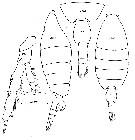 Issued from : C. Séret in Thesis 3ème Cycle, UPMC, Paris 6. 1979 [Pl. XXXVIII, Figs.252-255]. Female (from off Kerguelen Is.): 252-253, habitus (dorsal and latezral, respectively); 254, last thoracic segment and urosome (dorsal); 255, P5.
|
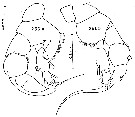 Issued from : C. Séret in Thesis 3ème Cycle, UPMC, Paris 6. 1979 [Pl. XXXIX, Figs.256 a, 256 b]. Male: 256 a, right P5; 256 b, left P5.
| | | | | Compl. Ref.: | | | Sewell, 1948 (p.575); Björnberg, 1973 (p.345, 387); Ward & al., 1995 (p.195, Table 2); Errhif & al., 1997 (p.422); Razouls & al., 2000 (p.343, tab. 3, 5, Appendix); Park & Ferrari, 2009 (p.143, Table 3, 8, fig.2, Appendix 1, biogeography) | | | | NZ: | 5 | | |
|
Distribution map of Heterorhabdus pustulifer by geographical zones
|
| | | | | | | | | 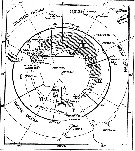 issued from : W. Vervoort in B.A.N.Z. Antarctic Reseach Expedition, Reports - Ser. B, Vol. III, 1957 [Fig.124] issued from : W. Vervoort in B.A.N.Z. Antarctic Reseach Expedition, Reports - Ser. B, Vol. III, 1957 [Fig.124]
Chart showing the geographical distribution (white circle) in the seas surrounding the Antarctic continent.
Nota: In this chart the area frequented by whaling vessels has been hatched. The Antarctic circle (66°.5 S) has been drawn as a broken line. The numbers I to VI refer to the sectors into which the Antarctic seas are divided according to Mackintosh (1942) (after Vervoort, 1951). |
 Issued from : E.T. Park & F.D. Ferrari in A selection from Smithsonian at the Poles Contributions to International Polar year. I. Krupnik, M.A. Lang and S.E. Miller, eds., Publs. by Smithsonian Institution Scholarly Press, Washington DC., 2009. [p.167, Fig.2]. Issued from : E.T. Park & F.D. Ferrari in A selection from Smithsonian at the Poles Contributions to International Polar year. I. Krupnik, M.A. Lang and S.E. Miller, eds., Publs. by Smithsonian Institution Scholarly Press, Washington DC., 2009. [p.167, Fig.2].
Distribution of selected pelagic calanoids Heterorhabdus pustulifer of the Southern Ocean and the closest relative in the subarctic region of the Arctic Ocean. |
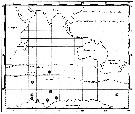 Issued from : C. Séret in Thesis 3ème Cycle, UPMC, Paris 6. 1979, Annexe. [p.49]. Issued from : C. Séret in Thesis 3ème Cycle, UPMC, Paris 6. 1979, Annexe. [p.49].
Geographical occurrences of Heterorhabdus pustulifer in the Indian Ocean and Antarctic zone. [after publications from: Brady, 1883, 1918; Thompson, 1900; Wolfenden, 1908, 1911; With , 1915; Rosendorn, 1917; Farran, 1929; Sewell, 1929, 1947; Brady & Gunther, 1935; Steuer, 1929, 1392, 1933; Ommaney, 1936; Vervoort, 1957; Tanaka, 1960; Brodsky, 1964; Seno, 1966; Andrews, 1966; Grice & Hulsemann, 1967; Seno, 1966; Frost & Fleminger, 1968; Voronina, 1970; Zverva, 1972].
Nota: C. Séret notes the occurrence at stations 56°S, 70°E and 46°S, 64°E. |
| | | | Loc: | | | Antarct. (Indian, Drake Passage, SW Pacif., Ross Sea), sub-Antarct. (South Georgia, Indian, Kerguelen Is., SE Pacif.), S Indian (subtropical convergence), New Zealand (SW South Island), Chile (41° S)
Type locality: 71°41' S-71°49' S, 166°47'W-167°32'W.
For Park (2000, p.124), the species has a circumantarctic distribution. Besides the type locality (Farran1929), Vervoort (1951) found this species at 66° S57) betweejn 66°30' S and 47°43' S and between 54°16' E and 164 °29' E in the Indian Ocean sector of the Antarctic.; Park (2000) at 60°42' S, 59°48' W in the Drake Passage., 11° W in the Atlantic sector of the Antarctic; Vervoort (19 | | | | N: | 11 | | | | Lg.: | | | (31) F: 3,2; (25) F: 3,15-2,7; M: 2,88; (35) F: 3,04-2,98; (102) F: 3,2; (246) F: 3,34; 3,12; M: 2,74; (399) M: 3,2-2,6; (824) F: 3,24-3,04; M: 3,16-3,04; {F: 2,70-3,34; M: 2,60-3,20} | | | | Rem.: | "Abyssalis" Group.
meso-bathypelagic.
Sampling depth (Antarct., sub-Antarct.) : 0-600 m.
According to Vervoort (1951, p.128) this species is characterized by the tubercle on the dorsal surface of the genital segment of the abdomen, but for the rest resembles H. austrinus, norvegicus and abyssalis. The outer edge spine on the 2nd exopodal segment of female P5 is slightly shorter than the 3rd exopodal segment; in Farran's specimens they are of the same length.
Bradford (1971 b) does not follow up on the opinion of Vervoort (1957) regarding a possible synonymy between this species and H. autrinus. Bradford (1971 a, p.128) noted that one male of H. pustulifer, taken in the Ross Sea (at 75°09'S, 171°W) was incorrectly identified as H. austrinus.
Séret (1979) specifies the characters of the male P5 that is described more detailed by Park (2000, p.124). | | | Last update : 20/05/2017 | |
|
|
 Any use of this site for a publication will be mentioned with the following reference : Any use of this site for a publication will be mentioned with the following reference :
Razouls C., Desreumaux N., Kouwenberg J. and de Bovée F., 2005-2025. - Biodiversity of Marine Planktonic Copepods (morphology, geographical distribution and biological data). Sorbonne University, CNRS. Available at http://copepodes.obs-banyuls.fr/en [Accessed December 24, 2025] © copyright 2005-2025 Sorbonne University, CNRS
|
|
 |
 |















